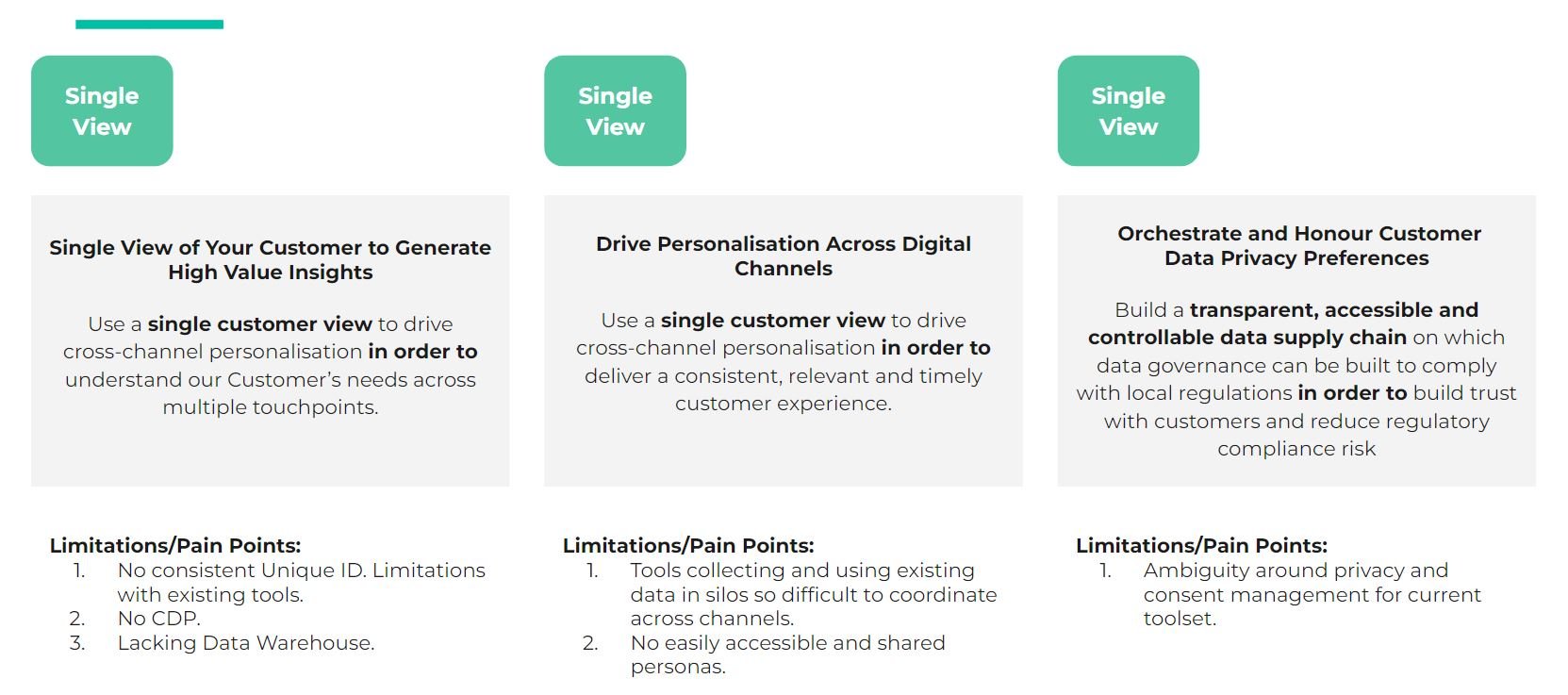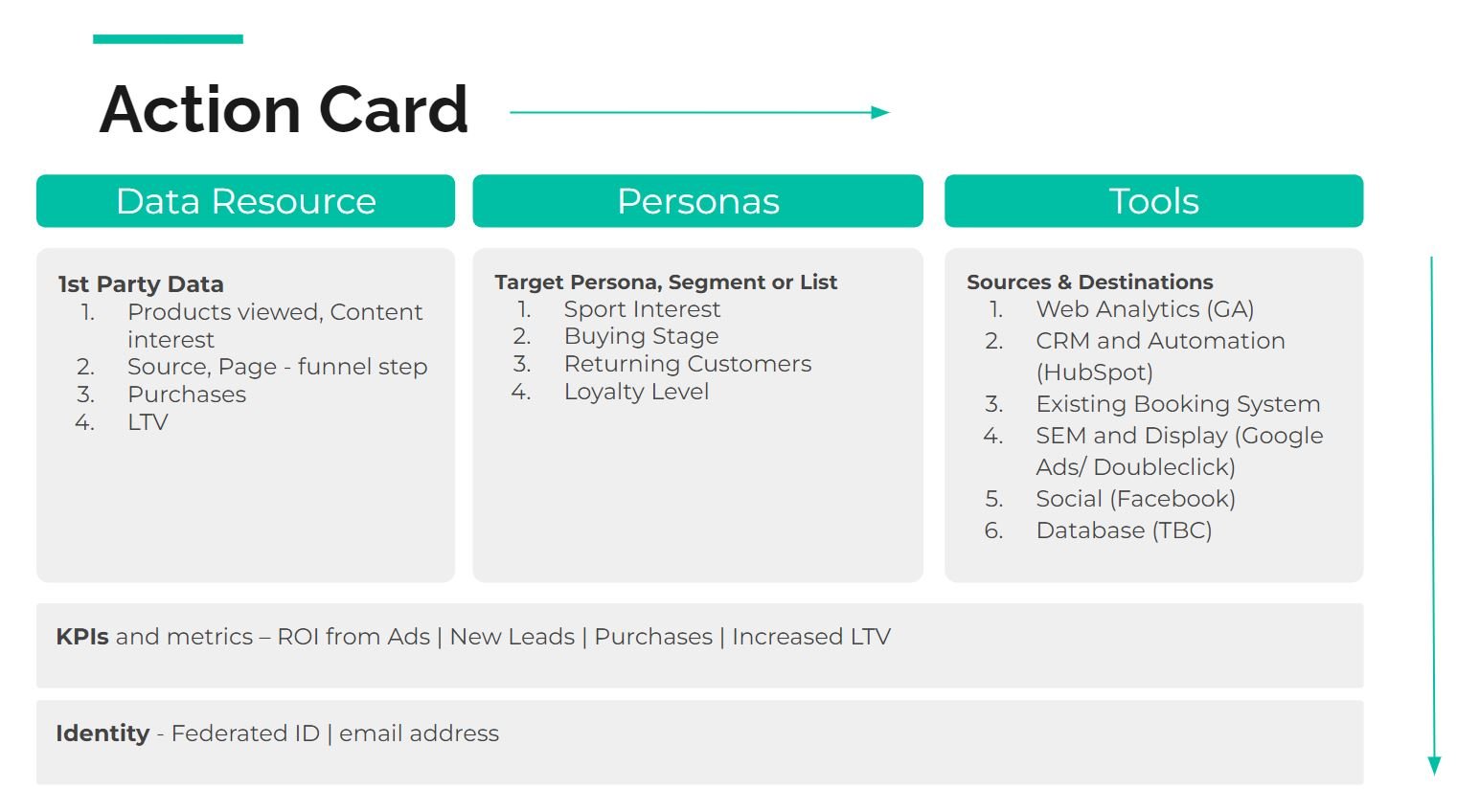Personalisation Strategy in a Nutshell
Let’s pull it all together. Whichever personalisation strategy we choose, we must make sure it aligns with our overall business strategies – for example, whether ROI is more important than revenue or you’re looking to focus on loyalty rather than growth. Perhaps you have lots of offline data points. Then it might be that a personalisation strategy around location-based marketing is the best option to work towards.
We can use a framework like the personalisation strategy matrix below to assess predictably and consistently which strategies may be most appropriate. Remember our self-question exercise at the start of this chapter? It is these answers that can guide us to the right personalisation strategy for our organisation.
By breaking the process down into these steps, we can begin to assemble our own strategies.
Self-Survey, Risk and Readiness Review – get all our stakeholders together, looking for gaps, opportunities, and threats across the three pillars.
Review our Marketing and Business Strategy.
Define our Data Strategy accordingly.
Review the Personalisation Strategy Matrix.
Summarise our Findings in the Nutshell. Keep it all to one page and in simple language.
Pick our Personalisation Strategies, layering these as we progress up the Analytics Maturity Curve.
Use our Actions Cards to start planning our approach.
Circle back to Plan, Plan, Plan to properly document our decisions and planning.
Source: MckTui Consulting.
It also often makes sense to start with some strategies over others. For example, the most logical starting point is to build a Single Customer View by standardising and syndicating data collection. Often as part of that strategy, the first attribute we want to collect is permission status – specifically, do we have permission to use this data or not?
Source: MckTui Consulting.
We can see here how it’s possible to layer personalisation strategies over time to meet a loftier overall marketing or business strategy. By doing this, we can make the task more achievable, breaking it down and supporting our organisation and other shipmates to come along for the ride. We can show how something potentially dull (even though we know it’s not), like data privacy, is just a step to award-winning and profitable personalised omni-channel campaigns.
With hundreds of potential strategies, how do we decide on the best one to recommend for our organisation? A good way to start is to condense our information onto cards and attempt to summarise our findings in a nutshell, like the one below. This can help to focus our thinking.
What may also be helpful here, and could be included in our ‘Nutshell’, is how this relates to our overall marketing and business strategy.
-----------------
Source: MckTui Consulting.
In a nutshell: By implementing a Federated ID across marketing touchpoints and linking to data preferences, we can de-risk shoe-in.com from accidental leaks or misuse of first-party data and use first-party data to drive better ROI through more relevant communications.
Introduction of a Data Warehouse and CDP for improved syndication of toolsets and data.
The next step could be to include offline data as part of the personalisation strategy.
---------------
When we have identified a personalisation strategy to work towards, we can summarise our plan into Audience Action Cards. These cards can help focus our minds on what customer data points we have (these can be referred to as attributes) and what we need, how that data can be used to build personas, segments, or audiences (whichever terminology we’re most comfortable with).
Once we have this, we can work forward across and then down the card and plan what tools our data is going to be sourced or extracted from and what possible destinations might be part of our overall Solution Design and MarTech Stack that our data will flow into. The data is our target audiences, their attributes and segments, and other key metrics and dimensions that we want to activate across our marketing campaigns.
Source: MckTui Consulting.
It is especially important to ensure we include our key performance indicators in this summary to show that those metrics are important and ensure that data is available. It is just as critical to think about all the potential identifiers and how they will be tied together in something like the previously mentioned Federated ID.
There may be a fair amount of work involved, but we now have a structure to follow. It’s only now that we have enough information to start looking at new tools and talking to outside vendors.
Depending on where you are with your journey, you may need to go back to your Solution Design to evaluate the necessary tools in your stack, or you may be able to proceed.
Now you know what is on the line if the courts decide that your company or organisation has misused personal data.
We’ve added some additional frameworks to our kit and reviewed some of the most used Personalisation Strategies while reviewing what might be a most suitable fit for our Business and Marketing Strategy along with current progress and where we may need to improve.
Next, don’t pass GO but collect two hundred pounds, and Let’s Go Tool Shopping (Chapter 8).
What tools are we missing, and what must we consider in order to make good decisions?




